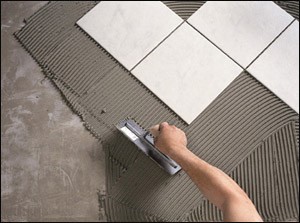Ceramic Tile – Before, During, & After Install
Installation day is coming, know this to prepare.
So, you’ve reviewed this site, smartly shopped our store and have made your ceramic purchase decision. Well done, but you’re not completely done. Allow us to offer two more words of advice: be prepared. Get ready for the day your new ceramic flooring will arrive for installation. Being prepared and involved will help ensure that the installation process is done smoothly and efficiently, and, hopefully, eliminate expressions of “I wish I’d asked about…”. Knowing what to expect will also be a lot less stressful on you, your family and your home. To that point, we’ve built this section around many of the things you should be aware of, plan ahead about, and carefully consider.
Let the pros do the job.
Installing this type of floor is difficult work, labor-intensive and extremely exacting. We strongly recommend you call upon a reliable, seasoned, dedicated professional to install your ceramic floor. That way you can be assured of a beautiful, efficient and correct installation. However, while installing ceramic tile flooring is a skill that is developed through years of experience, your understanding of the basics of installation will increase your knowledge of the process and enhance your confidence in the professionals working in your home. Ceramic tile installers are craftsman with age-old skills. Expertise has been handed down from one generation to the next over dozens of centuries.

The substrate is where it all begins.
Over the years, new methods and materials have been introduced, but tile setting remains the same hand-operated, labor-intensive process that it has been since ancient times. That process begins with the preparation of the tile foundation, or what’s called the substrate. Common materials used as tile substrates in home installations include concrete, plywood, and drywall. Each substrate has its own unique set of issues, yours included, and is prepared according to industry and manufacturer guidelines. So you can rest assured it’s done to recognized standards.
The first step in your ceramic tile installation involves the cleaning of the substrate. Dirt, moisture, and oil can interfere with the adhesion of the tile, so care is taken to remove all foreign debris prior to beginning. Next, the installers will level the surface of the substrate. Why is this step necessary? It’s to provide a strong support base for the tile, and to ensure that the individual tiles will appear flat when installed. Flat, obviously, is the goal. If the substrate is not level or flat, the result could be tiles not being set correctly that can cause chipping or cracking when weight is applied. Once the substrate has been leveled, it may have a waterproofing layer applied to it. This is important in installations where the tile is frequently exposed to moisture, like kitchens, bathrooms, and exteriors.
Through thick and thin, tile setting has progressed.
In the past, ceramic tile was installed using what is called the thickset or mud set method. In this method, a thick layer of mortar was applied to a waterproofed and steel reinforced substrate. This provided a strong, flat base onto which the tile was installed. The thickset method is effective, but it’s an involved and labor-intensive process. An alternative method was searched for – and found.
Today, many tile installers have opted for the industry accepted and more efficient thin set method, where the tile is adhered directly onto a backer board that is nailed to a plywood or concrete substrate using a much thinner layer of mortar. This backer board is called a CBU, or cement backer unit, which provides a supportive and water-resistant layer between the porous substrate and the mortar and tile applied on top of it.
The best-laid ceramic floors are planned.
Once the substrate has been prepared, the next step is to create a layout plan. This plan shows the dimensions of each room, and will help determine the amount of ceramic tile and other materials needed for the installation. The installer will use this plan to estimate the amount of product needed, and to anticipate any installation issues that may be caused by architectural features like stairs, transitions, and cabinets. The installers will also use the layout plan to determine the pattern and orientation of the installed tile.
Chalk keeps things straight.
A chalk line is commonly used to lay down a guide for the installer to work from. This leaves a temporary line that can be used as a straight guide. Forget point “A”, installers start at point “T”. Next, a single row or column of tile is laid directly on the substrate without adhesive. This step gives the installers a better sense of how the tile will fit into the room. Another row or column is then added perpendicular to the first, forming the shape of a ‘T’, giving the installer a starting point for their tile setting. Once the installer has determined the correct layout, the next step is to apply the adhesive mortar to the substrate.
Next, grout comes into play.
Once the tiled floor has been set into place and left to fully cure, usually 12 to 24 hours, the grout is applied. Grout is available in a wide range of colors, and in sanded and unsanded forms. Sanded grout is commonly used for grout joints that are wider than 1/8th of an inch. This type of grout joint is typically used with floor tile because it helps strengthen the tile joint, and it will not sag after it is cured. Unsanded grout is used with narrow grout joints typically found with wall tile and many natural stone installations.
So, you may be wondering, how long before I can walk on my new floor? The mortar and grout need 24 hours to cure before walking on the tile. This ensures that the tiles won’t shift or become loose before the adhesive thin-set mortar and grout have a chance to set. In some installations the tile may be mopped daily for several days to prevent the grout from cracking, pulling moisture from the underlying mortar, or curing unevenly. And that is how your new ceramic floor would be professionally installed.
What to know and do during installation day:
Furniture is first on your to-do list.
Remove all furniture and other objects and materials from the areas where the installation will take place. Some installers will move your furniture, but there may be an additional charge for doing so. Before moving, you’ll also need to empty the contents of china cabinets, closets, etc. Be aware that the area of installation must be climate controlled (heated or air-conditioned). Indoor humidity should be maintained between 45-65%.
Make a decision on your old floor covering.
Please consider how your old floor covering will be taken up and disposed of. We recommend that you check with us about the cost and the method of disposal. If you prefer to remove your present floor covering yourself, do it at least one day prior to installation to allow for cleanup and floor preparation. If removing old carpet, please leave tack strips in place and pull the staples out of the floor from the original pad.
Now turn your attention to the trim.
In many cases, moldings and baseboards need to be removed for installation. Your installer may do this but at an additional charge and they will probably not be responsible for damage or breakage due to dry or brittle wood. Painted baseboards, woodwork and paint may need retouching after the installation is complete. If necessary, this is your responsibility.
Next on the list is the subflooring.
Your existing subfloor may need to be prepared to receive the ceramic, or a new subfloor may be required. We suggest you discuss this with us and, if subfloor work is necessary, that it be done by qualified professionals. It is important that the subfloor be as clean and level as possible.
Know this about your doors.
When your new floor is installed, there’s always the possibility that the doors, especially closet, basement and bedroom doors, may not clear the new floor and swing free. Some installers will remove doors in order to install the new floor and re-hang them if possible. They probably won’t shave or cut down doors to insure clearance. You should check with us as to their policy and the cost. You may need to arrange for a qualified carpenter to provide this service after the installation of your new floor.
Check up on the clean-up.
Installing new ceramic will produce waste. Usually these materials are collected by your installer and left at your trash collection site. Check with us before the day of installation, so you’re clear about the cleanup, if there are added costs to do so, and ask about the plan for remnants.
What to know and do before installation day:
Plan on being home.
Be prepared to be at home the day of installation and be available in case the installation crew has questions. Your presence will ensure that the correct ceramic is installed in the right areas. Because it is difficult to estimate the length and circumstances of each job, some installers may not be able to give you an exact time of arrival. We suggest you be flexible and keep in touch with us.
We insist on wall-to-wall safety.
Your installers will use a variety of tools and techniques that can make the work area hazardous. Please make sure that your children and pets are kept out of the work area on installation day.
Walk through, don’t run.
We recommend that, prior to the completion of the installation, you walk through the job with the chief installer. This will give you the opportunity to ask questions and be clear on any final details.
What to know and do after installation day:
If you are sensitive to dust and odors, good ventilation should be established for 48 to 72 hours after installation. When it comes to preparing for your ceramic tile installation, we want you to know all about the steps to take and the issues to consider. That way, installation day is a positive experience and the first of many days of enjoying your beautiful ceramic tile.

